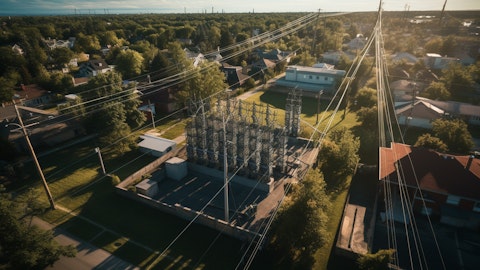Rejji Hayes: I would say it’s largely due to the latter and that’s incremental CapEx. So, remember, we have the electrical liability roadmap that we provided – that we filed with the commission in late September of last year. And so, that had $3 billion of incremental CapEx opportunity versus the prior vintage. We haven’t incorporated all of that. But about half is, as per Garrick’s prepared remarks, so call it roughly a good portion of that $1.5 billion step up in our new plan versus our old plan. We also do have increased renewable investments. But I wouldn’t say that that’s sort of the deferrals that are coming into 2024 from 2023. Yes, there’s a little bit of that, but it’s largely an additional IRP execution on the renewable side, as well as our voluntary green pricing program.
So I’d say the vast majority of that uplift from our five year CapEx plan, the current one versus the prior, is driven by electrical liability related investments, and then you’ve got a portion attributable to clean energy investments, largely renewables.
Garrick Rochow: Let me just reinforce that. And the way I would like to think about, add on to Rejji’s good comments there, is that clean energy piece in the supply, it’s what’s approved in our 2022 IRP. And the upside will be to the tail end because we haven’t built in any of this new energy law, as Rejji stated in some earlier comments. So, as that renewable energy plan is filed and eventually approved, then you’ll see that it will slightly hit the tail, but even beyond the five years, you can see a nice path of 10 years of investment opportunity as a result of this energy law.
Shahriar Pourreza: It just sounds like it’s more incremental versus shifting from 2023 to 2024. Okay. And then, just on the balance sheet, the $350 million in equity after 2025, I guess, does that contemplate sort of increases beyond the current CapEx plan as you look to ramp up reliability and renewable spending?
Rejji Hayes: This just incorporates the current five year plan of $17 billion of utility CapEx. And it’s enough work to prepare these five year plans. So we’re not thinking about year six through 10, just yet. So I would say that it’s, again, just the $17 billion utility CapEx plan and the funding associated there with. But as per my prepared remarks, we’re quite pleased that even with that upward pressure on equity needs as a result of that growing capital plan, we didn’t have to change the annual amount. So we’re still up to $350 million as we were in our prior plan, and it has a lot to do with just good cash flow generation and the plan to monetize tax credits as a result of the IRA.
Shahriar Pourreza: Last one is just on the Palisades, revival seems to be moving forward with the DOE loans. Does that change sort of the calculus maybe from a resource planning perspective? Would you be open to purchasing the power under an FCM construct? Or does it still seem too expensive for you?
Garrick Rochow: We’re watching the activity on Palisades. But I just want to remind everybody on the call here, we’re not involved in Palisades. And from a PPA perspective, it’s spoken for, both with two coops. And so, we’re not engaged at all within that process. Now, we hope, from an implication perspective, we think it’s great for Michigan, and we wish them well and success in getting the plan up and operational.
Shahriar Pourreza: So no change in your resource planning is, I guess, the point was.
Garrick Rochow: No change in the resource planning. And I would just remind everybody, even with that potential out there, we see great opportunities in energy and capacity that are evident at Dearborn Industrial Generation.
Operator: The next question comes from David Arcaro with Morgan Stanley.
David Arcaro: Congratulations to both Sri and Jason. Really great working with both of you. I was curious if you could give your latest thoughts on load growth expectations here and whether you’re seeing any increased activity in manufacturing or data center growth kind of hit the radar.
Garrick Rochow: Let me start and then I’ll pass it over to Rejji too. There’s a lot of great things going on in Michigan from an economic development perspective. Onshore and friend-shoring, benefits of the CHIPS Act, IRA, we’re seeing growth in polysilicon, we’re seeing growth in semiconductors, we’re seen growth in agricultural processing, battery manufacturing, and parts that go into vehicles and the like. So just a lot of manufacturing growth, which I love. Frankly, it creates jobs. It has a supply chain that goes with it. And frankly, there’s a lot of margin in those areas. To your point, we’re also seeing some data center growth. That’s part of the plan. But we get really excited with the manufacturing side just because of the other additional benefits that are associated with that.
So, that’s kind of a big level picture. And that pipeline continues. We’ve got a nice pipeline of growth into the years. And I want to remind everybody, we’re playing conservatively. And we’re not counting any of that upward supply and sales type opportunities until we see the meter spinning. So that’s just our conservative approach. But let me hand it over to Rejji for some additional comments.
Rejji Hayes: David, I think Garrick summarized it pretty well. And the big takeaway here is we plan conservatively. But what I’m pleased to represent, just to add some numbers to Garrick’s good comments is that, you think about the last several planning cycles we’ve had, we’ve suggested that we’ve had sort of flat to stable or slightly declining load growth. And it’s always important to remember that our load growth math includes our energy efficiency actions where we’re basically reducing load year-over-year by 2%. And so, if you that into account, we’ve been up about 2% or thereabouts on a gross basis for many years. But this current plan, on a five-year basis, offers about a 1% swing from where we were just in our last five year plan.
And so, we’re assuming little over 0.5% of growth over this five year plan, again, inclusive of our energy efficiency efforts. And so, even though Garrick highlighted that we have a pretty robust and diverse pipeline of opportunities, all we have embedded in our current five year plan are the two large projects that were announced over the last year or so with Goshen and Ford. And so, that’s really all we have incorporated in our plan. And I’ll tell you, candidly, we’ll be disappointed if that’s all we’re talking about in the next two to three years, given, again, the breadth and depth of our pipeline today. So good opportunities going forward on the load front. We’re already seeing that in the numbers, but I think there’s more opportunity going forward.



